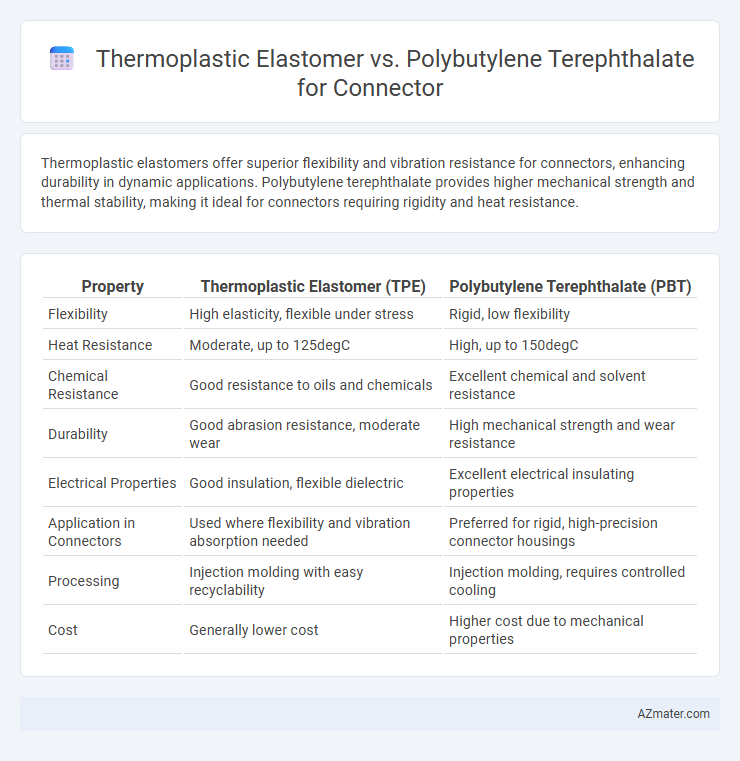Thermoplastic elastomers offer superior flexibility and vibration resistance for connectors, enhancing durability in dynamic applications. Polybutylene terephthalate provides higher mechanical strength and thermal stability, making it ideal for connectors requiring rigidity and heat resistance.
Table of Comparison
| Property | Thermoplastic Elastomer (TPE) | Polybutylene Terephthalate (PBT) |
|---|---|---|
| Flexibility | High elasticity, flexible under stress | Rigid, low flexibility |
| Heat Resistance | Moderate, up to 125degC | High, up to 150degC |
| Chemical Resistance | Good resistance to oils and chemicals | Excellent chemical and solvent resistance |
| Durability | Good abrasion resistance, moderate wear | High mechanical strength and wear resistance |
| Electrical Properties | Good insulation, flexible dielectric | Excellent electrical insulating properties |
| Application in Connectors | Used where flexibility and vibration absorption needed | Preferred for rigid, high-precision connector housings |
| Processing | Injection molding with easy recyclability | Injection molding, requires controlled cooling |
| Cost | Generally lower cost | Higher cost due to mechanical properties |
Introduction to Thermoplastic Elastomer and Polybutylene Terephthalate
Thermoplastic elastomers (TPE) are flexible materials combining rubber-like elasticity with the processability of plastics, making them ideal for connectors requiring vibration resistance and durability. Polybutylene terephthalate (PBT) is a crystalline thermoplastic known for its high mechanical strength, excellent electrical insulation, and chemical resistance, commonly used in precision connector components. Comparing TPE and PBT highlights a trade-off between flexibility and rigidity, influencing connector performance in different industrial applications.
Material Composition and Structure Comparison
Thermoplastic elastomers (TPE) consist of a block copolymer design combining rubber and plastic phases, enabling flexibility and elasticity ideal for connectors requiring vibration absorption and flexibility. Polybutylene terephthalate (PBT) is a semicrystalline polyester known for its rigid, high-strength structure with excellent electrical insulation and thermal resistance, making it suitable for durable, stable connector housings. The molecular structure of TPE allows for elastic deformation at room temperature, whereas PBT's crystalline domains provide dimensional stability and resistance against environmental stress cracking.
Mechanical Properties: TPE vs PBT in Connector Applications
Thermoplastic elastomers (TPE) offer superior flexibility and impact resistance compared to polybutylene terephthalate (PBT), making TPE ideal for connectors requiring repeated flexing and vibration absorption. PBT provides higher tensile strength, rigidity, and excellent dimensional stability, which ensures durable connectors suitable for high-stress mechanical environments. In connector applications, TPE excels in flexibility and shock resistance while PBT delivers robustness and precise mechanical performance.
Electrical Performance and Insulation Capabilities
Thermoplastic elastomers (TPE) offer superior flexibility and excellent electrical insulation properties, making them ideal for connectors requiring durability under mechanical stress and consistent dielectric strength. Polybutylene terephthalate (PBT) provides high dimensional stability and resistance to electrical tracking, ensuring reliable insulation and minimal electrical losses in high-frequency applications. While TPE excels in impact resistance and flexibility, PBT outperforms in thermal stability and resistance to electrical degradation over prolonged use.
Chemical Resistance and Environmental Stability
Thermoplastic elastomers (TPEs) exhibit superior chemical resistance to oils, acids, and bases, making them ideal for connectors exposed to harsh chemicals. Polybutylene terephthalate (PBT) offers excellent environmental stability with higher resistance to heat and UV radiation, ensuring longevity in outdoor or high-temperature applications. Choosing between TPE and PBT depends on the specific environmental conditions and chemical exposure the connector will face.
Processing Techniques: Injection Molding and Assembly
Thermoplastic elastomers (TPE) offer superior flexibility and impact resistance during injection molding, allowing precise customization for connector seals and overmolding applications. Polybutylene terephthalate (PBT) excels in high-volume injection molding with excellent dimensional stability, enabling tight tolerances and robust mechanical strength in connector housings. Assembly benefits from TPE's ability to form tight, resilient seals without additional gaskets, while PBT's rigidity ensures structural integrity and reliable mating with metal terminals.
Cost Analysis: TPE vs PBT for Connector Manufacturing
Thermoplastic elastomer (TPE) offers cost advantages in connector manufacturing due to its lower raw material price and reduced processing time compared to polybutylene terephthalate (PBT). PBT typically incurs higher tooling and cycle costs because of its rigid structure and longer cooling periods, impacting overall production expenses. Manufacturers often choose TPE when flexible design and cost-efficiency outweigh the mechanical strength and thermal resistance benefits provided by PBT.
Durability and Longevity in Harsh Conditions
Thermoplastic elastomers (TPE) offer excellent flexibility and impact resistance, making them ideal for connectors exposed to mechanical stress and vibration. Polybutylene terephthalate (PBT) provides superior chemical resistance and thermal stability, enhancing connector durability in corrosive or high-temperature environments. For harsh conditions, PBT connectors generally exhibit longer service life due to their robust resistance to wear, UV radiation, and moisture compared to TPE.
Popular Use Cases in the Electronics Industry
Thermoplastic elastomers (TPE) are widely used for connectors in the electronics industry due to their flexibility, excellent insulating properties, and resistance to vibration, making them ideal for wearable devices and flexible circuits. Polybutylene terephthalate (PBT) offers higher mechanical strength, chemical resistance, and dimensional stability, which suits connectors in automotive electronics, industrial equipment, and high-temperature applications. Choosing between TPE and PBT depends on requirements for flexibility versus durability and thermal resistance in electronic connector designs.
Conclusion: Selecting the Optimal Material for Connectors
Thermoplastic elastomers (TPE) offer superior flexibility, impact resistance, and vibration damping, making them ideal for connectors requiring high durability and repeated mechanical stress. Polybutylene terephthalate (PBT) provides excellent dimensional stability, chemical resistance, and high thermal performance, suitable for connectors exposed to harsh environments or elevated temperatures. Selecting the optimal material depends on application-specific demands, with TPE preferred for flexible, stress-resilient connectors and PBT favored for rigid, heat-resistant, and chemically robust connectors.

Infographic: Thermoplastic elastomer vs Polybutylene terephthalate for Connector
 azmater.com
azmater.com